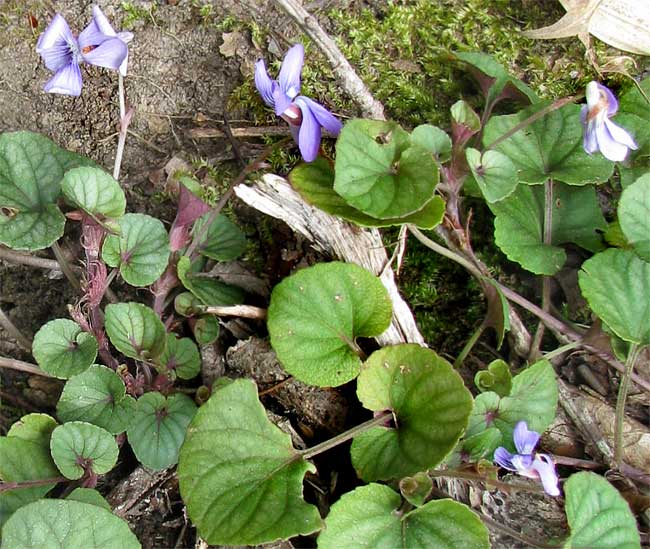Excerpts from Jim Conrad's
Naturalist Newsletter

from the the March 9, 2009 Newsletter, issued from the forest near Natchez, Mississippi; elevation ~400ft (120m), ~N31.47°, ~W91.29°:
PROSTRATE BLUE VIOLETS
The blue-flowered Common Blue Violets profiled a while back still are abundantly flowering in lawns and out in the woods, so it might be easy to overlook the blue-flowered violets commonly gracing the mossy, vertical slopes of the bayou below the house. However, the basic plant-body structure of what's down in the bayou is very different from that of the Common Blue Violet. Common Blue Violet leaves and flowers arise in a cluster from an underground root, like long-stem roses from a vase. What's down in the bayou has flowers and leaves arising from a slender stem that wanders across mossy cliff faces, as shown above.
About 19 species of wild-growing violet species are listed for Mississippi, and what's shown above is one of the several that at first glance look like Common Blue Violets, but aren't. Those are Prostrate Blue Violets, sometimes called Walter's Violets, VIOLA WALTERI.
Prostrate Blue Violets are distinguished from the other species mainly by those slender stems snaking across the ground. At the left in the picture notice how small leaves and flowers arise from the stem running parallel with the left side. Also notice the purplish, deeply cut, frilly items giving the stems a shaggy appearance. Those are stipules arising at the bases of leaf petioles. In most plants stipules are small and fall off early, but these are very conspicuous and long-lasting. Other violet species may have conspicuous stipules but few are so deeply cut into such narrow sections.
This species forms pretty, many-flowered mats on bayou walls and should be grown horticulturally for shady spots in gardens. Prostrate Blue Violet is a southeastern US species specializing in shaded, moist, rich soils.